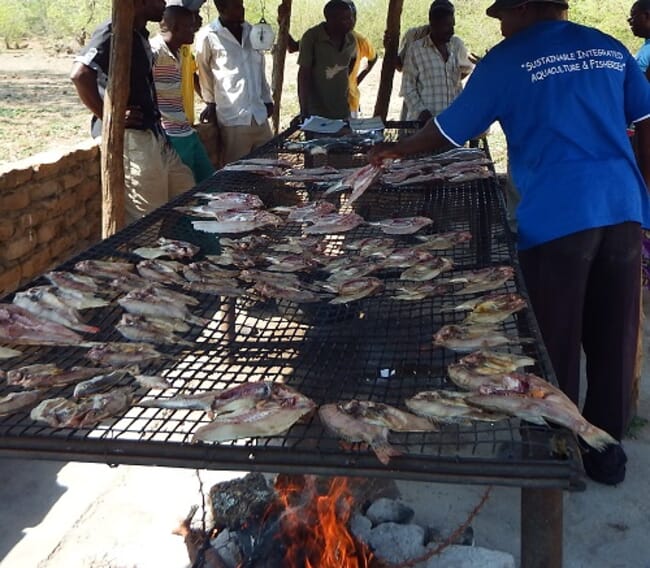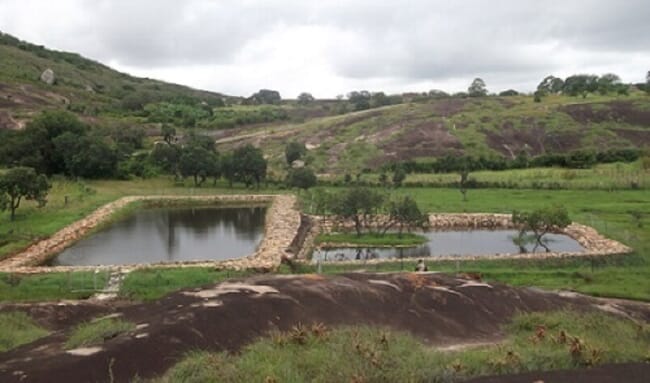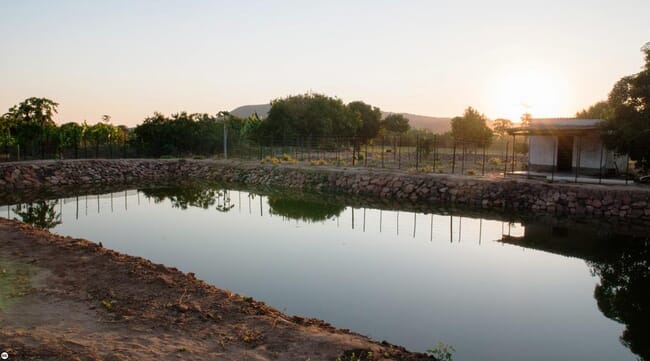Zimbabwe holds an estimated 60 percent of all the dammed water in southern Africa and is home to the largest freshwater fish farm in Africa. Yet less than 5 percent of the 400,000 hectares suitable for inland aquaculture is currently being utilised for fish production, according to the Zimbabwe Fish Producers’ Association.

© Aquaculture Zimbabwe
However, the government is working to develop fish farming and fish consumption in the country. On 21 December 2017 the Minister of Environment, Water and Climate, Oppah Muchinguri Kashiri, launched a US$432 million command agriculture programme that will incorporate livestock, fisheries and wildlife. The government and private funders will jointly finance the initiative.
In launching the policy, Muchinguri Kashiri said the government-led programme will fund projects in reservoirs and ponds across the country.
“We now have [fewer] dams because we lost some of them due to flooding and poor maintenance,” she said. “I want to make sure that most of them are fully utilised because some of them had become white elephants. In support of this command programme, through the Zimbabwe Parks and Wildlife Management Authority, my ministry’s primary focus shall be to ensure that all dams are fully stocked with fingerlings for the benefit of surrounding communities, thereby ensuring that their food and nutrition needs are met. To date 350 requests have been received from individuals and entities desiring to participate in the command fisheries programme.”
EU funding
Meanwhile the Integrated and Sustainable Fisheries and Aquaculture Production for Improved Food Security for Vulnerable Households in Zimbabwe project, which launched in 2013, is still running in eight of the country’s poorest and driest districts.
Three not-for-profit organisations – World Vision, Basilwizi Trust and Aquaculture Zimbabwe – are implementing the European Commission (EC) backed initiative in eight districts – Binga, Hwange, Insiza, Masvingo rural, Kariba, Umzingwane, Mwenezi and Beitbridge.
Clive Garaushoma, the fisheries co-ordinator at World Vision Zimbabwe, says the project has helped to improve the incomes, nutrition and fish farming skills of co-operative members. Some people who used to fish illegally in western Zimbabwe have had their operations formalised and market access enhanced, and are now able to bargain for better prices for their produce, he adds.
“When we started farmers were harvesting tilapia at an average of 150g because they lacked proper fish-farming skills,” he says. “Now that they have mastered the skills the average harvest weight is between 190g and 270g after every six- or seven-month cycle. A group of 16 people gets between US$3,000 and US$4,000 over the same period. This is a very good income for people who have no other revenue.”
Across Zimbabwe the EC has financed the construction of ponds covering 265,900 square metres that are being run commercially. The EC invested US$300,000 at the start of the project in November 2013.
Promoting a co-operative farming model, the initiative has supported 865 farmers operating 28 sites across the eight districts. Twenty-seven are earth ponds while one site, at Gache Kache near Lake Kariba, which forms Zimbabwe’s north-western border with Zambia, is under cage culture. Most of the ponds cover 1,000 square metres and are farmed by 16 co-operative members, although there are also a number of ponds that are double the size and have twice as many member farmers.

© Aquaculture Zimbabwe
“The fish density is six per square metre,” says Garaushoma. “This means that if a pond measured 1,000 square metres the co-operative would have around 6,000 fish. It is pleasing to note that with better fish-farming skills the mortality is less than 5 percent.”
In Hwange District, where Basilwizi Trust is the EC’s implementing partner, the project has tempered the game of hide-and-seek that went on between fish poachers and the police.
“In the district at Msuna, we are not working with co-operatives but fishermen who used to be poachers,” he says. “Now they are operating legally, each earning between US$300 and US$400 a month. Before we started working with them they could not bargain effectively for better prices so they got US$1-US$2 per kilogram but now they earn $2-$2.50 per kilogram.”
Cutting the fish import deficit
Both the government’s command fisheries initiative and the EC’s project to boost co-operative pond farming should help to reduce the production gap in Zimbabwe’s domestic market for fish. The country currently produces about 18,400 tonnes of fish every year, far below the potential national demand of 60,000 tonnes.
Basilwizi Trust has trained civil servants involved in the EC project as well as participating villagers in Binga and Hwange Districts in western Zimbabwe. In Binga 125 households are directly benefitting from fish ponds and agriculture improvements, while in Hwange the project is working with 60 fishermen and 15 traders.
In addition to the EC-funded programme, Aquaculture Zimbabwe is involved in a separate project that is financed by Global Environment Facility through their small grants programme.
The Muunganirwa Fish and Horticulture Cooperative, based in Bindura District in Mashonaland Central Province, 90km northwest of Harare, received US$50,000 in start-up support from Aquaculture Zimbabwe in 2013 for its aquaculture and fruit-tree project. The co-operative built 18 ponds, each of which measures 200 square metres and range from 1.3m to 60cm in depth.

© Basilwizi Trust
Aquaculture Zimbabwe says the project is improving its members’ livelihoods. “They have a better standard of living because they can make a living from the land,” said the organisation in a statement. “They have more protein in their diet which is available at any point in time. The project gets a lot of visitors from all over Zimbabwe and other countries, increasing their network. Some of these visitors end up being a potential market.”
Predator threats
Ishmile Muunganirwa, a spokesperson for the 69-member co-operative says business started off well and demand for fish has always exceeded supply. “We harvest three to four tonnes of tilapia every year, selling a kilogram for US$3,” he tells The Fish Site. “We have not managed to meet demand. However, we have been grappling with a big problem since the official launch of the project in 2015. Otters are destroying our project. They are nocturnal animals that raid our ponds at night and what we only see in the morning are the innards of the fish at the sides of the ponds. It is sad that they target the bigger fish and leave the smaller ones and when the smaller ones grow bigger, they are eaten as well.”
The co-operative has been seeking donor support to raise US$3,000 to erect diamond-mesh fences around the 18 ponds, says Muunganirwa. With the mature tilapia being eaten, the co-operative is resorting to selling fingerlings.
“If we get that money [US$3,000], we will be able to build a strong barrier against these predators,” he says. “Part of the money would be used to buy cement to fortify the base of the fencing since otters can actually burrow into the ground to avoid the fence and make a way into the ponds on the other side.”
“We have no idea where we can get that kind of money,” Muunganirwa continues, “but we desperately need it because the project cannot operate viably through selling fingerlings for US$60 per 1,000. We are meant to grow fish, sell mature ones and earn more money. We heard that the government launched a livestock and fisheries programme. This is a possible opportunity for us to benefit. We were trained so we have the skills; we have the foundation of a project that is already running. What we want is the money for fencing. On-site refrigeration and a refrigerated truck are also important, but without secure fencing we are handicapped.”


